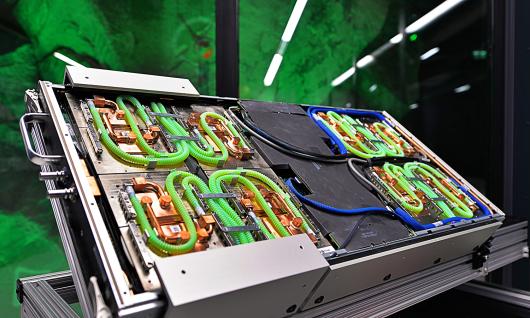— Now it's all about stress-testing and fine-tuning the system so we can ensure Olivia delivers to her full potential when she officially opens this autumn, says Stein Inge Knarbakk, Senior Project Manager at Sigma2
Research projects from academia, industry, and public administration will now test Olivia's capacity to optimise operations before the platform is made available to other projects.

The pilot projects, which include initiatives from SINTEF Energy, agritech company DigiFarm, and the University of Bergen, have been selected based on specific GPU tasks to be tested. Among other areas, these projects include climate modelling, language models, genome research, and chemical simulations, where machine learning plays a key role in analysing and interpreting large datasets.
SINTEF Energy’s GoHydro model will use Olivia to plan and optimise hydropower generation, with the potential to improve Europe's energy infrastructure utilisation.
— With Olivia as a test platform, we have the opportunity to exploit the unique architecture of shared memory between GPU and CPU cores, which can reduce the need for data transfer and provide significant efficiency gains. This new machine offers us a unique opportunity to maximise the potential of combining CPUs and GPUs, as we develop and tailor the solution algorithms and program code ourselves, says Hans Ivar Skjelbred, Research Manager at SINTEF Energy.
Agritech company DigiFarm, which has already achieved major breakthroughs using the European supercomputer LUMI, also looks forward to testing Olivia. DigiFarm develops innovative solutions for the agricultural sector based on the analysis of enormous amounts of satellite data using artificial intelligence. With Olivia’s capacity, the company hopes to accelerate development, increase model accuracy, and scale up its work further.
— Olivia could be a game-changer for us. Access to such an advanced technological platform allows us to develop models faster and with greater precision. This enables us to deliver solutions that could revolutionise the agricultural sector. For example, we can optimise resource use in agriculture and promote sustainable solutions in a sector facing increasing demands for efficiency and climate-friendly adaptations, says Nils Helset, founder and CEO of DigiFarm.

Professor Nathalie Reuter’s team at the University of Bergen will explore protein-membrane interactions, aiming to reduce costs and environmental impact by leveraging Olivia’s GPU technology.
— GPU-based calculations provide us with a fantastic opportunity to reduce both costs and environmental impact. Olivia will enable us to perform more extensive simulations and explore protein-membrane interactions with high precision, says Professor Nathalie Reuter, University of Bergen.
A Leap Forward for National Research and Innovation
Olivia represents a significant boost for national research and innovation, particularly in artificial intelligence (AI) and machine learning. Equipped with 304 of the most advanced GPUs on the market, Olivia will increase Norway’s national GPU computing capacity by approximately 17 times. This will allow researchers to perform simulations and analyses that were previously impossible, accelerating research processes and opening up new opportunities in AI development, medicine, energy system optimisation, and climate change modelling.